
Ectobiidae is a family of the order Blattodea (cockroaches). This family contains many of the smaller common household pest cockroaches, among others. They are sometimes called wood cockroaches. A few notable species include:
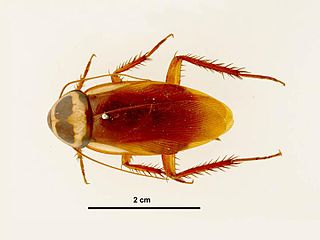
The Australian cockroach is a common species of tropical cockroach, with a length of 23–35 mm (0.91–1.38 in). It is brown overall, with the tegmina having a conspicuous lateral pale stripe or margin, and the pronotum with a sharply contrasting pale or yellow margin. It is very similar in appearance to the American cockroach and may be easily mistaken for it. It is, however, slightly smaller than the American cockroach, and has a yellow margin on the thorax and yellow streaks at its sides near the wing base.

Parcoblatta fulvescens, the fulvous wood cockroach, is a species of cockroach endemic to the United States and possibly Canada that measures around 13 mm (0.5 in) long.
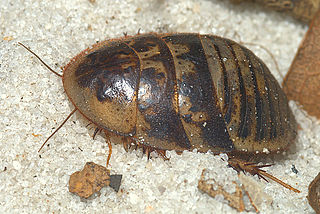
Arenivaga is a genus of sand cockroaches, of the subfamily Corydiinae, in the family Corydiidae. These cockroaches live in sandy soils and dunes in the southwestern United States, Florida and Mexico. Arenivaga comes from the Latin arena meaning sand and vagus meaning wandering.

The little big-eared bat is a bat species in the order Chiroptera and family Phyllostomidae. It is from South and Central America particularly Colombia, Venezuela, Guyana, French Guiana, Brazil, Peru, Ecuador, Bolivia, Argentina, Paraguay, Suriname and Trinidad. Though its exact population is unknown, it is considered widespread and occurs in protected areas, although deforestation may be a minor threat, it is classified as Least Concern. It is found in multistratal evergreen forests and dry thorn forests and forages near streams and is found hollow trees, logs, caverns, or houses with groups up to twelve. The head and body length measures at 44 millimetres (1.7 in) for males and 45 millimetres (1.8 in) for females. Males usually weigh about 5 grams (0.18 oz) while females weigh 5.7 grams (0.20 oz).

Anacridium aegyptium, the Egyptian grasshopper or Egyptian locust, is a species of insect belonging to the subfamily Cyrtacanthacridinae.

Omocestus rufipes, the woodland grasshopper, is a species of short-horned grasshopper belonging to subfamily Gomphocerinae. The Latin species name rufipes means red-footed, from rufus (red) + pes (foot), with reference to the color of the legs.

Spharagemon collare, the mottled sand grasshopper, is found in sandy-soiled, grassy areas of northern United States and southern Canada. They are known to be a minor pest of wheat crops; however, populations are rarely large enough to cause appreciable damage.

Cariblatta lutea is a small species of cockroach native to the United States and other countries, measuring usually around 7 millimeters long as an adult and under 2 millimeters from head tip to abdomen tip at the 1st instar or hatchling. It consists of two subspecies, the small yellow cockroach, and the least yellow cockroach.

Parcoblatta bolliana, Boll's wood cockroach or Boll's wood roach, is a small species of wood cockroach native to the United States, measuring around 11 mm (0.43 in) long.

Parcoblatta lata, the broad wood cockroach, is a species of wood cockroach native to the United States. It is one of the largest species of wood cockroaches.
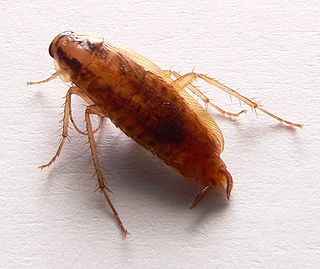
Blattellinae is a subfamily of the wood cockroach family, Ectobiidae. It includes the global household pest Blattella germanica, the German cockroach, and a number of endangered species. It contains about 70 genera.

Peripatopsis alba, the white cave velvet worm, is a species of velvet worm in the family Peripatopsidae. This species is notable as one of only two species of velvet worm known to be troglobitic; the only other velvet worm known to be a troglobiont is Speleoperipatus spelaeus. The white cave velvet worm is rare and limited to one cave system on Table Mountain in South Africa.
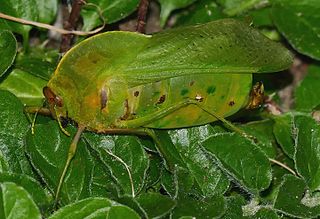
The Pneumoridae are a family of nocturnal short-horned grasshoppers in the order Orthoptera, commonly known as the bladder grasshoppers and the sole representative of the superfamily Pneumoroidea. Their centre of diversity is in southern Africa, but one species occurs as far north as South Sudan. Most adult males acquire an inflated abdomen, a specialization for amplified sound production, which is likely its primary function. Most genera display striking sexual dimorphism, and several species exhibit a dual male phenotype.

Evarcha brinki is a species of jumping spider in the genus Evarcha that lives in Northern Cape, South Africa. The species was first described in 2011 by Charles Haddad and Wanda Wesołowska. The spider is small, with a carapace measuring typically 2.5 mm (0.10 in) long and an abdomen 2.1 mm (0.08 in) long. It is generally yellow, with an orange tinge to the top of the carapace and a darker, nearly black eye field. There are large black spots on the abdomen. While the majority of the legs are yellow, the front pair are brown. It is very different to other African Evarcha spiders. Its copulatory organs are distinctive, particularly the male's embolus, which is short and encircled by a very thin appendage. The female has not been described.
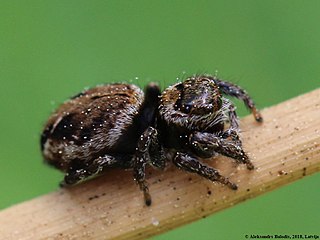
Evarcha mirabilis is a species of jumping spider in the genus Evarcha that lives in South Africa. The species was first described in 2009 by Wanda Wesołowska and Charles Haddad. The spider is small, with a dark brown carapace measuring typically 1.9 mm (0.07 in) long and a russet-brown abdomen that is typically 1.7 mm (0.07 in) long. It is similar to related species in the genus, particularly Evarcha maculata and Evarcha patagiata. The spider has a yellow pattern on the top of its abdomen, its underside being a uniform yellow, while the underside of the carapace is orange. The legs individually have a pattern of yellow, black, yellow. The pedipalps are similarly yellow and black. The male can be distinguished from others in the genus by its copulatory organs, particularly the shape of the projection from its palpal tibia or tibial apophysis, which is short and sharp and connected to the tibia through a large base. The female has yet to be described.

Melanoplus bispinosus, the two-spined spurthroated grasshopper, is a species of grasshopper belonging to the genus Melanoplus. This grasshopper is native to the United States.

Thoracistus is a genus of decticine or shield-backed katydids in the family Tettigoniidae. The mostly carnivorous genus is endemic to South Africa.
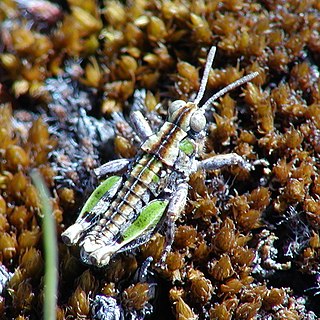
Sigaus minutus is a species of short-horned grasshopper in the family Acrididae. It is one of the smallest and rarest species of grasshopper in New Zealand, found only in the Mackenzie district of South Island. There are 13 species within the genus Sigaus described by Bigelow (1967), all endemic to New Zealand. The population status of Sigaus minutus is declining according to threat assessments made by orthopteran experts in 2010.

Tachycines asynamorus is a cave cricket and the type species of the genus Tachycines (Rhaphidophoridae). In English-speaking countries it is known as the greenhouse camel cricket or greenhouse stone cricket for its propensity for living in greenhouses. It was first described in 1902 by Russian entomologist Nicolai Adelung on the basis of specimens caught in the palm houses of St. Petersburg. Some authorities have placed this species in the genus Diestrammena, but it has now restored to its basonym.




















